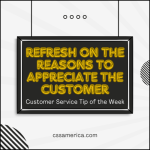Love Story – great movie. Alli McGraw. Ryan O’Neal. And a surprisingly poor rating on Rotten Tomatoes – but I digress. The most famous line from the movie is “Love is never having to say you’re sorry…”
Unfortunately, great customer service isn’t about love, per se. Many customers want to hear “I’m sorry” before they can settle down, move on, and forgive/forget.
So how do you say I’m sorry?
The Terrible Transfer – Let’s say that you answer the phone, and the customer immediately tells you they’ve already been transferred 4 times. Consider saying “Oh, I’m sorry to hear that. That’s not how we like to do things around here.” Then do the following; either: (A) Make sure you personally take care of the need, (B) Make a “warm” transfer once you identify the employee who can help and that they’re available, or (C) Offer to take their contact information and call them back with the answer.
The Technology Troubles – Let’s say that a customer is trying to understand how to use some technology platform your company provides or navigate your website, and they’re having issues. Consider saying: “I apologize for the difficulties in getting the system working.” You could then offer to walk them through the process on the phone, staying on the line until it works; you could offer to visit them to educate them on the process; you could also provide documentation on the key steps to getting their need addressed.
The Protracted Process – Maybe it’s a situation where a process is taking way too long (whether they want to get an application approved, get a meeting scheduled, get a return or request addressed). You could state: “Sorry that the process it taking longer than anticipated. I’ll personally make sure we get this addressed quickly.” After you’ve received details on the situation, take 2 approaches. First, immediately work on the issue and/or bring in someone to get the need addressed. Second, communicate actions to the customer while the process is in place (to manage expectations and keep them in-the-loop) and when the process is completed (to ensure they know the process was done and to confirm satisfaction).
Unfortunately, great customer service DOES MEAN that sometimes you have to say you’re sorry.
Handle apologies with aplomb.
Signup for FREE Tips! Contact Us More Resources for You Visit Our Home Page























